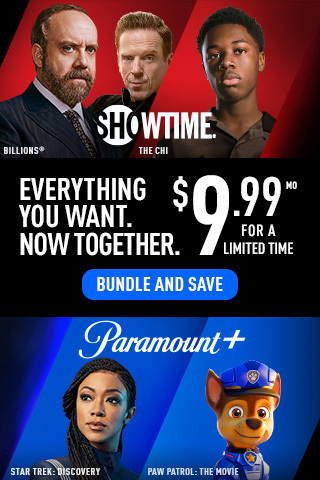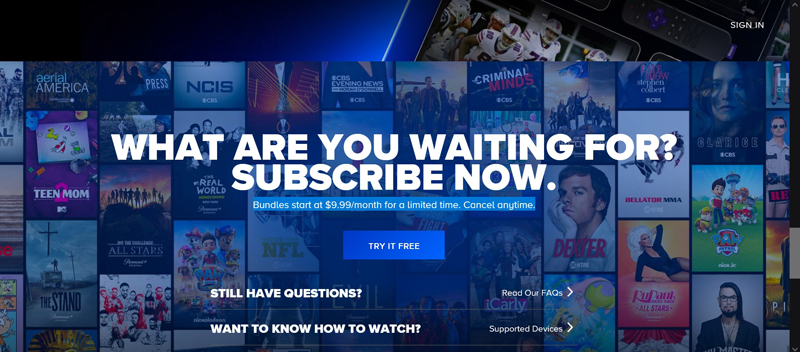
Corporate sibling video-on-demand streamers Paramount+ and Showtime roll out a price cut by selling themselves as a bundled package in the increasingly crowded and booming VOD landscape. The VOD package provides two options priced to consumers at $9.99/month in the Essential Plan or $12.99 for the Premium Plan, whose main differentiators are being more commercial free, 4K video and Dolby audio.
The Paramount+/Showtime offer was announced Sept 21. Both packages have sports — NFL football and soccer matches — on top of movies, TV series and CBS News content. Sports and news, though limited, inch closer to matching the “big basic” cable TV subscriptions with linear TV channels.
Paramount+ and Showtime are marketed to consumers as a good value with key copy lines “Bundle and Save” and “Everything You Want Now Together”; consumer marketing also says “For a Limited Time” suggesting the pricing will get jacked up and the two-for-one offer will end (it is believed consumers who take the bundle with have their price grandfathering when the sales promotion ends).

The website for the two bundled streamers contains text “Try It Free” and “Cancel Anytime.” The price makes the two streamers about the same cost as one streaming subscription elsewhere; top-of-the-line streaming services are around $8-15/month for commercial free. Separately, advertising-supported VOD services with mainstream movies and TV shows are about half that or less.
The bundle appears to be a 39% price reduction. Paramount+ by itself is $10/month or $5/month with advertising. Showtime is normally $10.99/month. And this is not their first bundle.
In August 2020, Apple TV+ launched a similar bundle offering Paramount+ (then called CBS All Access Ad-Free) and Showtime for $9.99 a month but had to be bought with Apple TV+ at an additional $4.99 monthly fee. The new Paramount+/Showtime combination is direct-to-consumer without going through any third-party platform.
Bolting together the duo of streaming services also underscores how large size is vital in streaming. Both Paramount+ and Showtime are owned by ViacomCBS, so they can join forces and also aggregate content from across their $27 billion-revenue parent. Disney+, which is viewed as second largest streamer, has been offered as a bundle with its Disney-owned siblings Hulu and ESPN+ since Disney+ launched in November 2019. Together, this Disney trio are bundled at a low price of $13.99.
As of midyear, Paramount+ had 42 million subs; the Viacom/CBS streamer is the rebranded CBS All Access. Showtime is the long-established the pay cable premium service; its streaming-only subs are difficult to break out from its cable base.
Signs of a competitive landscape are everywhere. Disney+ is now offering a free seven-day trail usage to subscribers who get a direct mail solicitation. “The return of the seven-day free trial comes after last June Disney+ ended the deal for new subscribers in the U.S.,” says a Fierce Wireless story by Ben Munson. “Earlier this week, Disney CEO Bob Chapek warned that Disney+ would see subscriber growth for the quarter ending in September in the low single-digit millions, compared with the 12 million subscribers the service added in the previous quarter.” So the direct mail initiative may be a short-term effort to lessen that de-acceleration.
In looking at today’s video streaming landscape, Netflix is the undisputed leader with 209.2 million subscribers worldwide and Disney+ is also in the top tier with 116 million subscribers as of August. Disney+ vaulted alongside Netflix so quickly because its parent Walt Disney Co. provided sizeable programming and financial clout.
Paramount+ and Showtime are in VOD’s second tier, which is crowded and offers uncertain prospects. Another mid-tier streamer is StarzPlay, with 16.7 million streaming subscribers as of May and whose parent company, Lionsgate, is Hollywood’s largest independent film distributor. Days ago, the Lionsgate vice chair predicted at an investors’ conference a general wave of mergers and acquisitions as players week to bulk up due to the VOD revolution, hinting Lionsgate will be in that mix. Also in that second tier for mainstream streamers including Amazon Prime, Apple TV Plus, Epix, Hulu and Peacock — which makes for a crowd.
Another mid-tier streamer, HBO Max, recently unveiled a six-month promotional price of $7.49 for six months for its subscribers on the Amazon Prime Video Channels platform, which is dropping direct access to HBO Max. At $14.99, HBO Max is the most expensive streamer. The linear HBO cable TV channels and associated streamer had 47 million subs midyear, but the sub-count announcement doesn’t break out how many subs are traditional cable and how many streaming via HBO Max.
Also in the Viacom/CBS business portfolio is leading ad-supported vid streamer PlutoTV, though it’s not involved in the just-announced bundle. PlutoTV had a sizeable 52 million subs at midyear. Because of advertising and emphasis on catalog content, PllutoTV is not a top-of-the-line streamer. Viacom/CBS owns Paramount Pictures, CBS Television Network, basic cable TV network Comedy Central, MTV, Nickelodeon and book publisher Simon & Schuster.

A marketing webpage for Paramount+/Showtime suggests “Try it free” and “Cancel anytime.”
Media/entertainment-sector companies are diversifying into VOD because of economics — they are big money spinners if successful — and can quickly get huge valuations from Wall Street. However, all subscribers are not equal. In some third-world overseas territories, subscriptions are far less expensive on a dollar basis in the U.S., though these are difficult to breakout when companies announce global subscriber counts. Wall Street investors tend just to look at total global subscribers, without accounting for low-priced subs overseas.
In January, 2020, a Wall Street analyst attributed a valuation of more than $100 billion to Disney+ for the parent company’s stock price, just two months after the streamer made its debut. Creating streamers involves setup costs that will weigh down short-term quarterly earnings with startup expenses. But success gets reflected quickly with rich valuations in parent company share prices. In contrast, owners of traditional linear TV channels these days are taking billions of dollars in write-offs and evaporating share-price valuations on these properties.
The lofty valuations of subscription-VOD streaming properties are warranted. Once launched, setup costs are covered and streamers can easily add any influx of new subscribers in a low-cost manner.
The Paramount+/Showtime bundling reminds me of a personal grocery story anecdote. My favorite soft drink is normally $2.25 for a two-liter bottle, but regularly goes on sale for five-for-$5. That bargain price certainly puts a squeeze on the soft-drink maker’s quarterly profits. But the five-for-$5 gobbles up all my soft drink spending for a month — my budget is spent so I won’t buy any other brand. In a world where consumers take one to three streaming subscriptions, selling at a two-for-one rate for Paramount+/Showtime gobbles up a big chunk of consumers’ entertainment budgets.
If the Par+/Showtime bundle elevates subscription levels, then Viacom/CBS share price is in line for a fatter valuation from Wall Street, even if the discounting crimps the parent’s quarterly profits.
Related content:
Leave a Reply